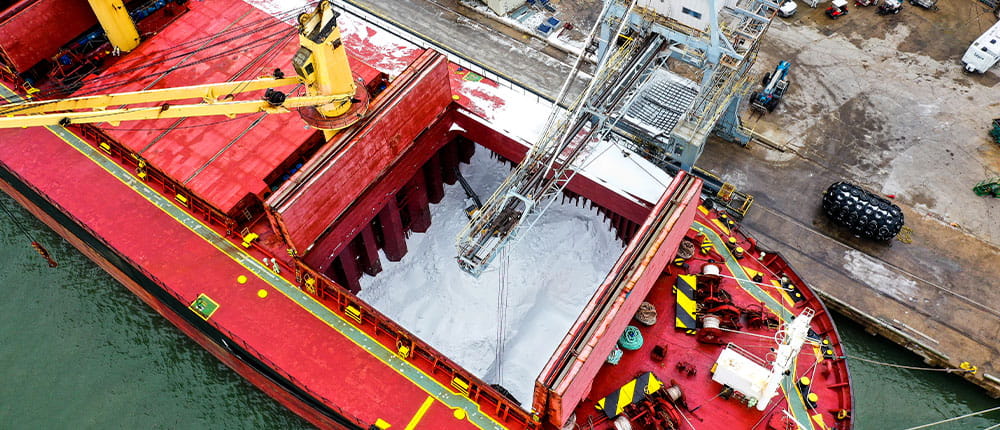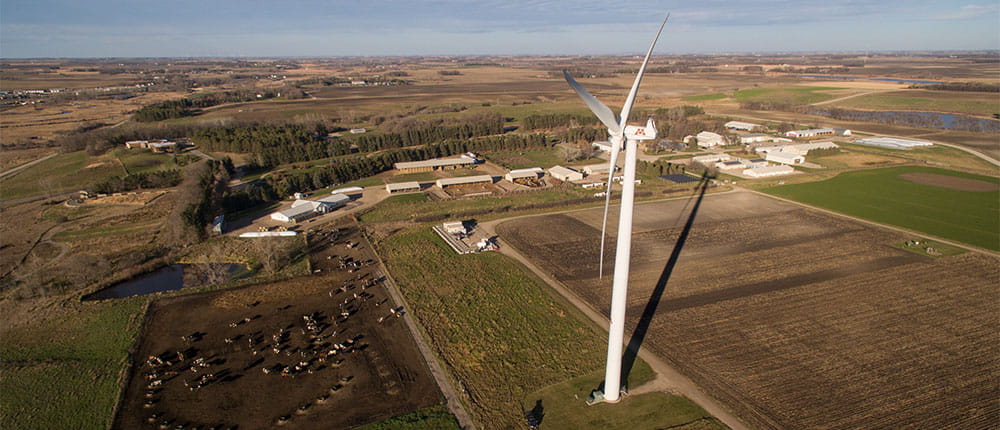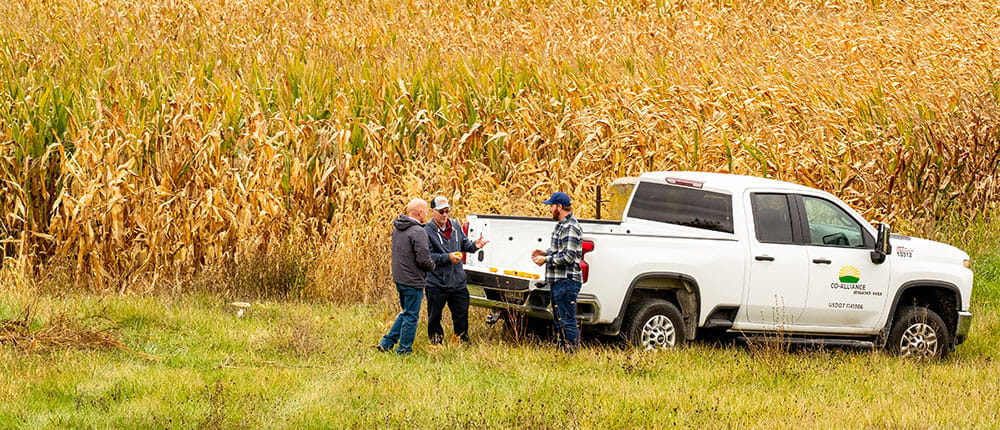Embracing the 4Rs of fertilizer — right source, right rate, right place and right time — helped Randy Bales increase yields and revenue on his Indiana farm while protecting the environment. Other factors contributed, too, such as adopting 20-inch rows and planting cover crops, but he’s confident that enhanced nutrient management is the key to long-term success.
“Losing fertilizer doesn’t help your bottom line and it hurts the environment,” says Bales, who farms with his son, Brad, near Lewisville. “The future of fertilizer is improved efficiency.”
Farmers couldn’t produce enough crops to feed a growing world without nitrogen (N), phosphorus (P), potassium (K) and micronutrients. Replenishing the soil after each cropping season is a must. But fertilizer production and use doesn’t come without environmental risks.
Farmers, agronomists and industry leaders say understanding and leveraging new technologies and following 4R principles will refine how fertilizer is made, applied and used by plants to make crop production more sustainable and productive in the future.
Roger Baker, who leads crop nutrient supply, trading and risk management for CHS, says nutrient use is starting to decline as adoption of enhanced-efficiency fertilizers and precision agriculture tools increases and application rules are implemented.
In 2021, U.S. corn farmers used 21.2 billion pounds of N, P, K and sulfur (S) compared to 21.5 billion pounds in 2018, according to the latest U.S. Department of Agriculture (USDA) data. The same nutrients used in wheat production totaled 4 billion pounds in 2022 compared to 4.4 billion pounds in 2019.
“Continuous improvement of nutrient efficiency from a cost and environmental standpoint will occur,” Baker says. “Some of that change will lie in the hands of regulators dictating how fertilizer is used, some with sustainability goals of businesses and some with better agronomic and management practices.”
Volatility will also shape the fertilizer industry going forward, says Corey Rosenbusch, president and CEO of The Fertilizer Institute, based in Arlington, Va. Many factors contributed to tight supplies and record prices in 2022 — anhydrous ammonia averaged $1,635 per ton in June 2022, according to USDA data, compared to the five-year average of less than $780 per ton — led by the ongoing war between Russia and Ukraine, lingering supply chain disruptions due to the COVID-19 pandemic and high natural gas prices.
“Combining that [volatility] with pretty good crop prices allowed fertilizer innovation to flourish,” Rosenbusch continues. “It spurred product development in biologicals, coatings, inhibitors and slow-release technologies. High prices also caused farmers to be more willing to experiment and be critical of fertilizer use to maximize inputs and yields.”
Focus on fertilizer placement
Bales farms nearly 1,800 acres of mostly corn and soybeans, mixing in about 40 acres of winter wheat or oats each year to diversify his crop rotation. To operate a sustainable farm, both economically and environmentally, Bales closely monitors agronomic research and follows 4R principles.
Green team
Wichita State University and Iowa State University researchers are teaming up to develop a system powered by renewable energy that reduces greenhouse gas emissions during fertilizer production.
The project will design materials, processes and reactors for the electrochemical capture and conversion of waste nitrogen and carbon dioxide to make fertilizer known as “green urea.” Scientists will also model the nitrogen life cycle in crops, develop nitrogen sensors for crops and educate farmers about the new fertilizer.
The National Science Foundation is supporting the project with a four-year, $4 million grant. Researchers Shuang Gu at Wichita State and Wenzhen Li at Iowa State lead the effort. Gu says fertilizer will always be essential for crop production, but producing more climate-friendly nutrients will enable a shift toward more sustainable agriculture.
“We’re dedicated to creating a better environment for future generations by providing affordable green fertilizer.”
He says one of his best decisions was to abandon planting crops in 30-inch rows in 2017 and switch to 20-inch rows and an enhanced management system based on research conducted by Fred Below, a University of Illinois crop physiologist.
“We’re going to have to increase yields while using less fertilizer,” Below says. “I’m convinced that better placement is the key.”
Below’s research over five years of testing shows a combination of banding granular fertilizer (N, P, S and zinc) under corn rows for easy access by roots, split-applying 240 pounds of N preplant and in-season, a foliar fungicide treatment and 20-inch rows with seeding rates of 40,000-plus plants per acre averaged 264 bushels per acre.
Corn in 30-inch rows at 32,000 plants per acre with no fungicide treatment and 180 pounds of N applied preplant and P and K broadcast-applied based on soil tests averaged only 213 bushels per acre — a 19% drop.
By mostly following Below’s management and adding soil health practices like planting cover crops on every acre to build organic matter, Bales was able to significantly increase corn production and net revenue. Average yields have increased from less than 200 to 225 bushels per acre, 18% better than the county average, Bales says.
Better fertilizer placement and timing — banding and split N applications — played a big role. “In our checks, if we didn’t band fertilizer, corn would be one growth stage behind corn in the areas where we banded,” he says.
Bales works with Eric Steigerwalt, an agronomist with Co-Alliance Cooperative based in Indianapolis, Ind. Together, they come up with annual cropping plans, which include use of enhanced-efficiency fertilizers.
“At Co-Alliance, our goal is to provide farmers with everything they need in a timely manner to practice the 4Rs appropriately,” Steigerwalt says. “The Baleses have done a great job implementing the 4Rs.”
Bales and Steigerwalt were selected as 4R Advocates in 2023 by The Fertilizer Institute. The organization annually honors three farmers and their fertilizer retail partners for their commitment to implementing fertilizer management practices that embody 4R nutrient stewardship.
Improvement to come
As precision ag technology, soil testing and data collection continue to improve, Co-Alliance soil and crop fertility experts say better nutrient management and use will follow. The cooperative serves farmers in Indiana, Ohio and Michigan.
Farmers have used yield data and GPS when taking soil samples to apply fertilizer at variable rates for decades, says Noah Freeman, Co-Alliance senior director of agronomy technology. Mining data using analytics, computer modeling and machine learning is improving by leaps and bounds that will improve fertilizer efficiency.
“In the future, we will have a better understanding of spatial variability in the soil to put fertilizer where it really needs to be,” he says. “As computation power continues to improve, we’re able to better determine limiting yield factors to write better variable-rate fertilizer prescriptions.”
In-season tissue testing and aerial imagery will continue to grow in popularity, Freeman adds, and pairing data and analytics will yield vital information to make better in-season and future nutrient decisions.
Already, airplanes and drones with multispectral sensors — RGB (red, blue, green), chlorophyll, thermal and NDVI (normalized difference vegetation index), for example — can identify distressed plants, often before the human eye can detect problems. Co-Alliance hires 40 college interns each summer to serve as crop scouts and most now use drones for scouting.
More emphasis will be placed on reducing fertilizer loss and carbon sequestration through financial incentives to farmers, says Caleb Smith, Co-Alliance sustainability director. He helps producers sign up for sustainability programs that pay them to use conservation practices such as cover crops and no-till. He says farmers earn $30 to $40 per acre on average.
“If they want to get paid for practices that improve fertilizer efficiency and nutrient stewardship, we take care of every step in the process at no charge,” Smith says. “We anticipate more companies outside agriculture will rely on farmers to meet their supply chain decarbonization targets. I think we’re on the forefront of connecting growers to these opportunities.”
Enhanced-efficiency fertilizer
With increased economic and environmental pressures, CHS fertilizer experts say growers must maximize their fertilizer investment by minimizing nutrient loss.
Jake Niederer, senior director of phosphate risk management at CHS, says the cooperative will continue to develop and improve enhanced-efficiency fertilizers. These products include controlled-release fertilizer, ammonia volatilization inhibitors and nitrification inhibitors.
“We need to continue to embrace those products and bring them to market,” he says. “We always ask ourselves, ‘Can we do more with less?’ That’s the essence of conservation and good community stewardship.”
Leading-edge efficiency fertilizer products are growing in popularity.
Trivar® is the first fertilizer additive specifically designed for broadcast phosphorus applications. It increases the availability of phosphorus and other key nutrients to plants. Trivar includes Levesol®, which is an advanced, patented nutrient-efficiency solution with a unique, scientifically proven chelate that makes phosphorus, zinc and other micronutrients more available to plants. Levesol solutions are available for dry and liquid fertilizers.
N-Edge® nitrogen stabilizers protect fertilizer investment. N-Edge Pro is applied to both above-ground and belowground applications of urea and UAN to protect against leaching and denitrification.
“There’s always ongoing work to improve our products and develop new ones,” says Todd Mackendanz, senior director of nitrogen risk management at CHS. “We’ll continue to partner with producers who are active in research and development to bring new products to light that will enhance fertilizer efficiency,” Niederer adds.
Green ammonia
Global efforts are underway to reduce carbon emissions. Many companies have sustainability goals, which may dictate future fertilizer production and use. CHS has partnered with CF Industries, one of the world’s largest producers of fertilizer, to accelerate production and distribution of low-carbon nitrogen fertilizer to further sustainability efforts.
“Farmers also want to do their part to help the environment and be good stewards of the land,” Baker says, noting low-carbon N is one way to meet sustainability goals.
CF Industries is investing in technology to sequester carbon and produce green ammonia, which is made using hydrogen from carbon-free sources, according to the company. CF Industries is constructing North America’s first commercial-scale green ammonia production site at its Donaldsonville Complex in Louisiana. The project, expected to be complete at the end of 2023, will be able to produce up to 20,000 tons of green ammonia per year.
The fertilizer manufacturer is also constructing a carbon dioxide (CO2) dehydration and compression facility to capture and store up to 2 million tons of CO2 per year as early as 2025.
Smith of Co-Alliance envisions a day when commodity premiums, commodity prices or both will be linked to carbon intensity of crop production. He says green fertilizer products — ammonia and potash — could play a pivotal role in helping farmers maximize revenue potential.

Fertilizer supply chain improvements
Strengthening the fertilizer supply chain and providing price risk management tools are a priority for CHS and the cooperative system, says Baker.
A $30 million investment in the CHS deep-water port at Galveston, Texas, will improve the heart of the cooperative’s fertilizer import and distribution system. More than 450,000 tons of urea and 120,000 tons of phosphate are imported through the terminal each year, then shipped to CHS and cooperative warehouses or hub plants, mostly by train.
Port improvements will increase ship unloading speed from 600 tons to 1,200 tons per hour and shrink the time it takes to load railcars, each carrying up to 96 tons of fertilizer. The investment is geared to ensure farmers get the nutrients they need when they need them.
“Galveston is an integral asset in our supply chain,” Baker says. Another key component is strategically placed hub plants, which each hold about 10,000 tons of fertilizer and distribute crop nutrients to cooperatives and retailers.
Baker says dry fertilizer storage capacity at CHS hub plants is roughly 1 million tons and storage capacity at member cooperative hub plants is another 1.5 million tons. “To fill that storage, we need to secure logistics for the future. That’s one reason why we are investing in Galveston — to secure import availability for CHS and our owners.”
Co-Alliance Cooperative is strengthening its own fertilizer supply chain by increasing dry storage capacity, automating liquid loadout facilities so farmers can get products whenever they need them and refining fertilizer purchasing. The co-op recently invested $15 million in its Mt. Summit Ag Center in eastern Indiana, which includes a new dry fertilizer hub that holds 26,000 tons.
“We strive to provide the best prices and product availability. If our fertilizer hubs aren’t full in the middle of November when we’re applying, it doesn’t do anyone any good,” Freeman says. “Investments made in facilities and logistics help farmers make the most of their fertilizer investment.”
Next-generation nitrogen

The fertilizer and agriculture industries are under pressure to reduce their carbon footprint. A next-generation green ammonia plant being built at the University of Minnesota West Central Research and Outreach Center (WCROC) in Morris will help.
Traditional anhydrous ammonia production uses natural gas and contributes more than 1% of global greenhouse gases, says Mike Reese, WCROC director and green hydrogen and ammonia lead. The new plant uses clean, renewable energy to make fertilizer. Eventually, he believes regional green ammonia plants will dot the landscape, which would be a win for farmers and the planet.
“It’s a matter of when, not if, facilities will start producing green ammonia. There’s interest from farm groups, utilities, fertilizer companies and energy companies,” Reese says. “If farmers use green sources of nitrogen fertilizer, it reduces fossil fuel use and pollution. It also reduces the carbon intensity of agricultural products such as ethanol, meat and eggs,” which could increase their value.
Making the vision a reality requires economic feasibility. Ten years ago, scientists at WCROC developed what was then first-in-the-world technology using wind power to pull nitrogen from air and hydrogen from water to make 6 pounds of anhydrous ammonia per hour.
The pilot project proved the technology works but needed to be scaled up to compete with plants churning out thousands of tons of anhydrous ammonia a day.
The new plant, funded by a $12.5 million U.S. Department of Energy grant, will use the center’s existing 1.65 megawatt wind turbine and 250 kilowatt solar farm to produce 15 times more fertilizer than the first facility, or 1 metric ton per day. It’s scheduled to come online in September 2024 and undergo several years of testing.
The project is part of a process to scale up production of green anhydrous ammonia to at least 30,000 metric tons a year per plant, which Reese says is attainable.
Check out the full fall 2023 C Magazine with this article and more.




